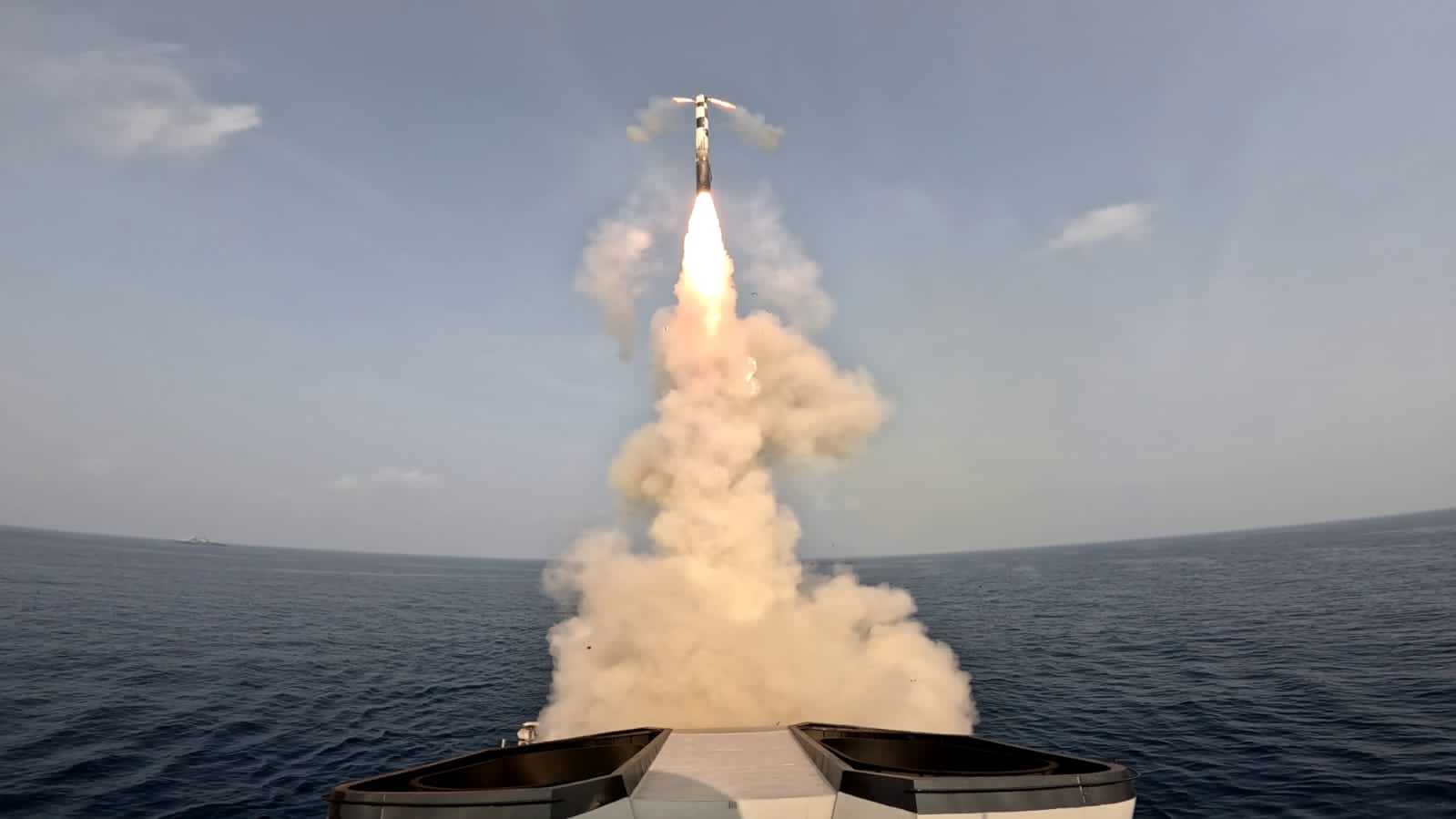The Times of India reported on October 20, 2025, that tests are underway toward developing an 800-km range variant of the BrahMos high-supersonic cruise universal missile. The variant is expected to be operational within two years.
The missile will reportedly feature a modified ramjet engine and “other upgrades.”
“The 800-km BrahMos is more or less developed in terms of the modifications to its ramjet engine. A few more tests are required to test the efficacy of its combination of internal INS (inertial navigation system) and external global navigation satellite systems to ensure high accuracy, resilience, and resistance to jamming,” a source told the ToI.
Development History
The BrahMos missile had an initial flight range of 280 km.
During Aero India 2017, then DRDO chief S. Christopher told reporters that the configuration of the BrahMos missile had been tweaked to enhance its range from 290 km to 450 km.
A BrahMos official at the event told the author that the extended range was achieved by enabling the missile to cruise at a higher altitude.
Earlier, in order to limit the range of the BrahMos to conform to the MTCR limit of 300 km, the missile was programmatically limited to flying at altitudes that would not allow it to achieve higher ranges.
Also, during Aero India 2017, the DRDO chief announced the development of an 800-km-range variant of the BrahMos. Christopher stated that the missile could be tested in two and a half years.
A BrahMos official whom I spoke to explained that the 800-km range would be achieved by optimizing the cruise performance of the missile’s ramjet engine and through the use of composites to reduce missile weight, allowing an enhanced fuel load.
The official emphasized that the weight and external dimensions of the missile would not be altered.
“The missile is already very heavy; to the extent that it cannot be kept slung on a parked aircraft for long,” he explained.
Development Landmarks
On May 22, 2018, DRDO tested BrahMos with an indigenously developed fuel management system and other non-metallic airframe components. The subsystems are critical to the development of the 800-km range variant of the missile.
In July 2021, during the MAKS-2021 air show, a source in the defence industry confirmed to TASS that an 800-km variant of the BrahMos was being jointly developed by Russian and Indian scientists.
The TASS source stated that the new BrahMos version has “a lot of new items.” In particular, it features a new booster.
Analysis
Based on media reports, it can be summarised that BrahMos Aerospace is relying on the following measures to increase the range of the BrahMos missile from the present 450 km to 800 km.
1. Reduction in the weight of the missile due to the use of lighter materials such as carbon fiber.
2. A more efficient solid-propellant rocket booster to launch the missile and propel it to high supersonic speeds to enable the ramjet engine to light up. It is likely that the booster takes the missile to a longer range before the ramjet lights up.
3. A more fuel-efficient ramjet engine.
DRDO appears to have mastered the challenges posed by points 1 and 2 listed above.
As mentioned earlier, DRDO has already tested a BrahMos with non-metallic airframe components to reduce its weight.
Booster For Extended Range
DRDO first tested an indigenous version of the BrahMos on March 11, 2017, using the Mobile Autonomous Launcher (MAL) deployed in full configuration from the Integrated Test Range (ITR) Chandipur at sea in Balasore, off the coast of Odisha.
On September 30, 2020, DRDO reportedly carried out a test of the booster for the ER variant of the missile from a land-based mobile launcher at 10:30 am.
The Indian press reported that the ER variant of the missile was tested. However, the PIB release covering the test stated that the missile “featuring indigenous Booster and Airframe Section along with many other ‘Made in India’ sub-systems was successfully flight tested for the designated range at 1030 hours today on September 30, 2020, from ITR, Balasore in Odisha. It is one more major step in enhancing the indigenous content.”
The release added, “Today’s successful launch has paved the way for the serial production of the indigenous booster and other indigenous components of the powerful BrahMos Weapon System.”
Putin’s “Terrorizing Weapon”: Has Russia Mastered Variable-Thrust Missile Tech That Can Outdo THAAD?

Improved Ramjet
Initially, BrahMos Aerospace assembled BrahMos missiles in India using liquid-fuel ramjet engines (LFRJs) produced at a plant in the Orenburg province of Russia. Later, BrahMos Aerospace signed a technology agreement with its Russian counterpart to facilitate the indigenous manufacture of the engine.
The test launch of the BrahMos-A in September 2021 was a major milestone in the complete indigenisation of the BrahMos missile. During the test, the structural integrity and functional performance of the missile with a locally manufactured liquid ramjet were proven.
India is currently using locally manufactured liquid-fueled ramjet engines on the BrahMos.
Major airframe assemblies, which form an integral part of the ramjet engine, are indigenously developed by the Indian industry. These include metallic and nonmetallic airframe sections comprising the ramjet fuel tank and pneumatic fuel supply system.
Indigenous manufacture of the Russian ramjet engine paved the way for the development of an indigenously developed LFRJ tweaked to increase the range of the BrahMos missile.
Indigenous LFRJ
DRDO embarked on developing its own liquid-fuel ramjet engine (LFRJ) capability in 2018. DRDO’s Annual Report 2018 stated that DRDL is developing a technology demonstrator liquid-fuel ramjet engine of 350 mm diameter for potential applications in missiles and aerial targets.
In June 2024, BrahMos Aerospace’s CEO Atul Dinkar Rane told Sputnik India that “the development of ramjet engine remains the foremost priority interest area for DRDO. It is a very critical and complex technology. If and when we achieve it successfully, we expect to be able to reduce per-unit BrahMos production cost.”
On May 8, 2024, the DRDO announced that one of its labs had achieved success in developing liquid ramjet fuel for an advanced air-breathing engine.
“Defence Materials and Stores Research and Development Establishment (DMSRDE) has made a landmark achievement by developing liquid ramjet fuel for an advanced air-breathing engine. This fuel has been tested successfully at the Ramjet Test Bed at DRDL on 08 May 2024. M/s BPCL and M/s Mineral Oil Corporation Pvt Ltd are industry partners in this development,” DRDO posted on X.
Conclusion
Having painstakingly mastered and then improved upon the technology that went into the BrahMos missile, the DRDO is now well poised to field an 800-km variant of the BrahMos. Most of the development work is completed.
A test of the more efficient LFRJ remains.
- Vijainder K Thakur is a retired IAF Jaguar pilot, author, software architect, entrepreneur, and military analyst.
- Follow the author @vkthakur




